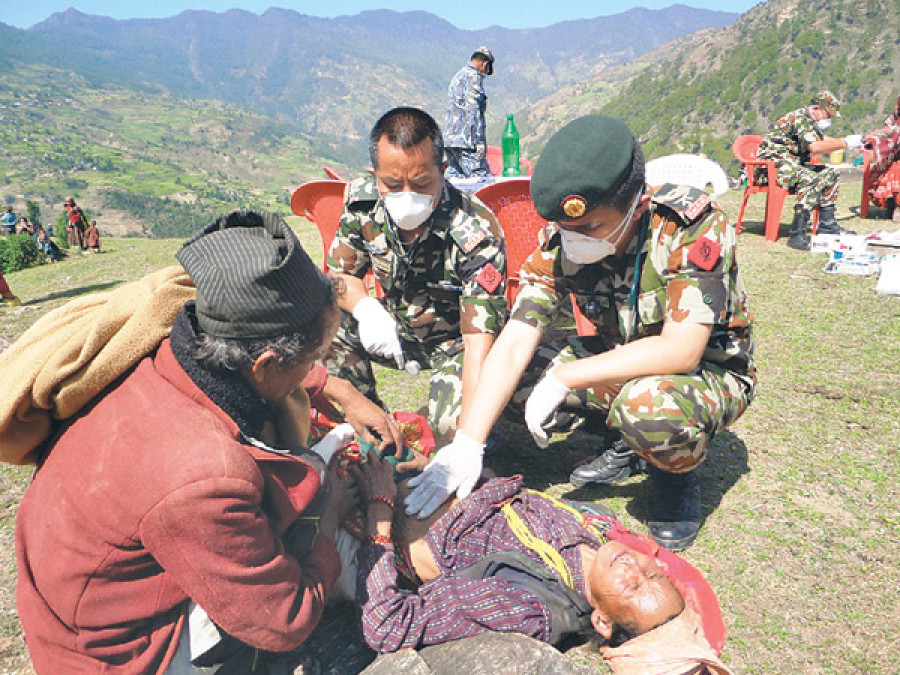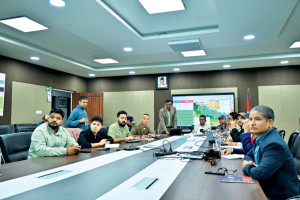Miscellaneous
Fearing for the worse
Half-hearted response to swine flu outbreak in Jajarkot has raised fear of the disease spreading in neighbouring districts as well
Post Development Bureau
The epidemic has been gradually spreading to other neighbouring districts because hospitals remain under-prepared and the district administration lacks precautionary measures. A similar incident of diarrhoea outbreak in 2009 in Jajarkot had taken 350 lives.
Ominous signs show that the neighbouring districts may be on the edge of an impending disaster. Jumla and other surrounding districts have been witnessing a surge in number of people suffering from viral fever.
Dr Surya Man Limbu, acting medical director of Karnali Academy of Health Sciences, says many people are coming to the hospital with the same symptoms seen among Jajarkot folks. “H1N1 influenza might have entered Jumla for patients are visiting the hospital with complaints of similar symptoms,” said Limbu.
A slow response of the government, mysteries surrounding the disease and the failure to establish a cause, remoteness of the affected areas, denial of the doctors to go there and affected people’s lack of access to proper medical care, food and sanitation have raised fears that the outbreak might get worse in weeks to come, say experts.
Cases of H1N1 influenza have been reported in several neighbouring villages of Mugu, Dailekh, Rukum and Dolpa. Rajan Adhikari, public health officer of Mugu, confirms that there has been widespread reports of cough and fever. “We have increased vigilance as medical tests have confirmed H1N1 strain in some of the patients,” said Adhikari.
Worse, the government has not been able to provide adequate health care support to people in Jajarkot, four weeks after the outbreak. Sushila Rokaya of Paika, Jajarkot, could not get basic health care in her village as the only auxiliary health worker was on a sick leave.
Sushila, who was brought to the district headquarters after three days of viral treatment, said many patients were suffering without proper health care. Her story is just a tip of the iceberg. Most people remain without access to basic health facilities. Many others take a tough journey just to find health posts and hospitals.
The Post’s reporters say Mid West and Far West districts are ill prepared to tackle the disaster due to inadequate human resources and medications. At a time when the government spends billions in providing various medicines at free of cost, the public still fails to get their hands on necessary medications. Patients are often given date expired medicines due to lack of effective monitoring.
Locals in districts adjoining Jajarkot have raised serious concerns over the authorities’ indifference in preventing the disease from spreading. Government officials, however, say they are doing their best. “We are increasing our vigilance in border check points and requesting people to use masks,” says Prashuram Nepali, senior auxiliary health worker at Mugu.
The government’s persistent failure to tackle such disasters has not only shed light on the condition of the country’s health system but also raised questions on how health funds are being utilised, say experts.
The government had allocated Rs 33.69 billion for the health sector, 6.5 percent of the total budget in fiscal year 2013-14. The total health expenditure was Rs 22.84 billion a year before that. In fact, the government has been allocating a significant portion of the funds to Jajarkot in recent years. The government had spent Rs 35 million alone to make the district the first open free defecation district in Bheri zone.
Mahesi Mahato, sub-division head of the district’s drinking water and sanitation project, says that there has been little improvement, if any, in areas of sanitation. “The disease outbreak explains that our efforts have made little progress,” says Mahato.
(With inputs from Bhim Bahadur Singh and Durga Lal KC in Jajarkot, Krishna Gautam in Surkhet, Raj Bahadur Shahi in Mugu, Motilal Poudel in Surkhet, Biplav Maharjan in Salyan)
Govt response sparks sense of deja vu
Six years after a cholera epidemic in Jajarkot claimed more than 350 lives, the remote district in mid-western Nepal is once again grappling with an outbreak of a disease far worse and contagious than cholera. Swine flu has already killed 24 people in Jajarkot while hundreds of others have been taken ill. The authorities, however, are yet to confirm if all the people who are down with flu-like symptoms in many villages of Jajarkot are suffering from swine flu.
It’s deja vu all over again in Jajarkot. Just like the cholera epidemic of 2009, the government and its agencies have woefully failed to respond to the latest health crisis in the district.
After witnessing the country’s worst epidemic in Jajarkot, the government was expected to create protocols and procedures, and preventative and rapid response services to deal with epidemics including swine-flu. It did not.
“We are dealing with this otherwise preventable health crisis because of our lack of foresight and incompetence,” says Dr Laxmi Raj Pathak, former director general of Department of Health Services.
Lack of preparedness and failure to learn the lesson from the not-so-distant past are why the people in Jajarkot are in the throes of the latest epidemic.
And nothing captures the height of government apathy to Jajarkot crisis more clearly than health officials, led by Health Minister Khaga Raj Adhikari, flying to the district and returning with only throat swabs of some patients and not their blood samples.
The laboratory in Kathmandu had to wait for four days for the blood samples to arrive to conduct the test.
Like any other outbreaks, the flu-like disease was reported from a Jajarkot village, among a group of men who had recently returned after employment in India. Soon, the disease proliferated, afflicting the people in other villages.
When a lot of people present identical symptoms at the same time, that is when the ground level health workers have important role to play, according to health experts.
“We have health posts in every VDC. It is the duty of the health worker stationed at these health posts to report the increase in number of cases related to flu,” says Dr Pathak. “But I doubt if health workers were available.”
Once the reporting is done, it is the duty of the public health office to conduct a thorough investigation into the matter, inform the Epidemiology and Disease Control Division (EDCD) in Kathmandu or any other surveillance site nearby. The EDCD should then coordinate with the local bodies, look into the severity of the cases and identify if the disease could explode into an epidemic. The laboratory test, diagnosis, and deployment of human resources to contain the disease should follow immediately. None of it happened in Jajarkot.
The reporting was late, the diagnosis was delayed and the deployment of doctors and medics took place three weeks after the disease became widespread and the toll escalated.
“Epidemics can be predicted and discerned in advance. Analysis of the causes and patterns of certain symptoms and diseases could help understand this,” says Dr Pathak. “The same mistake was made in 2009 and the case has repeated in 2015.”
Almost three weeks after the disease exacerbated and claimed many lives in Jajarkot, the government finally came to the conclusion that H1N1 influenza was the main cause of the outbreak. The A H1N1 pdm 09 strain of the influenza was found in eight samples taken from Jajarkot patients. The strain is the same that caused a global pandemic in 2009, which according to the World Health Organization, killed more than 18,000 people globally.
“Laboratory test is crucial to know the disease and conduct the treatment. However, it is yet to be prioritised,” says Dr Geeta Shakya, director of National Public Health Laboratory.
There are 40 surveillance systems based in hospitals across the country to report diseases that have potential of being an epidemic. The fact that only around 20 of these hospitals report to the EDCD shows the lack of concern of health care system to contain epidemics. Moreover, most of these surveillance systems are urban-centric and cannot address the health woes of people living in remote VDCs of Jajarkot or elsewhere.
Dr Jagdish Prasad Agrawal, medical educationist, says a strong health system is crucial to deal with health crises. “If we could only make medical schools accountable towards the society than the crisis like in Jajarkot could be averted,” suggests Dr Agrawal. “This crisis also calls for an equal distribution of medical colleges.”




 20.12°C Kathmandu
20.12°C Kathmandu









